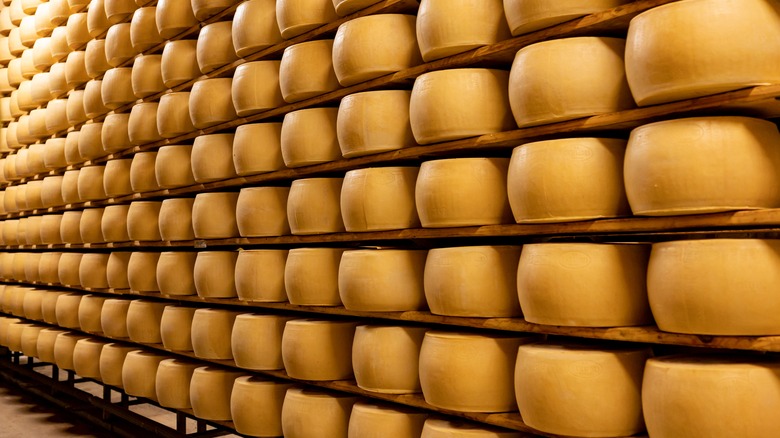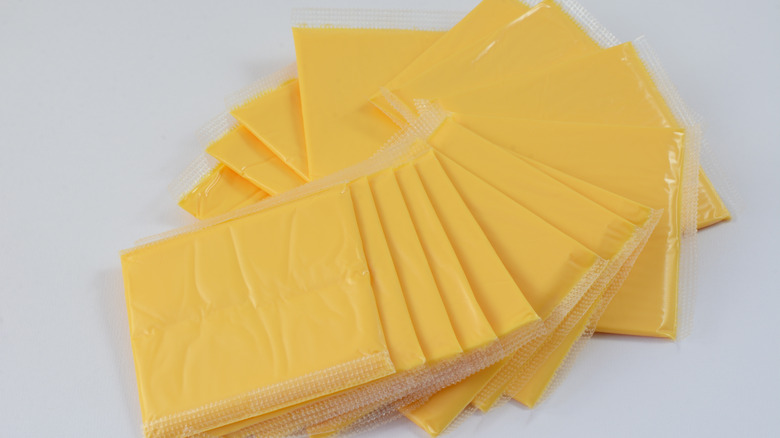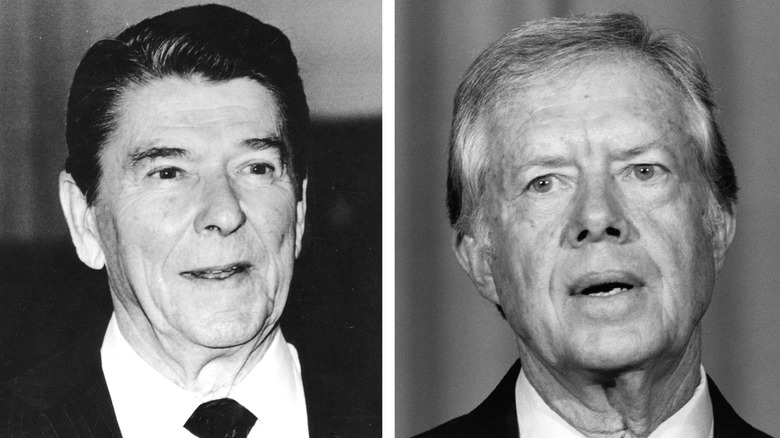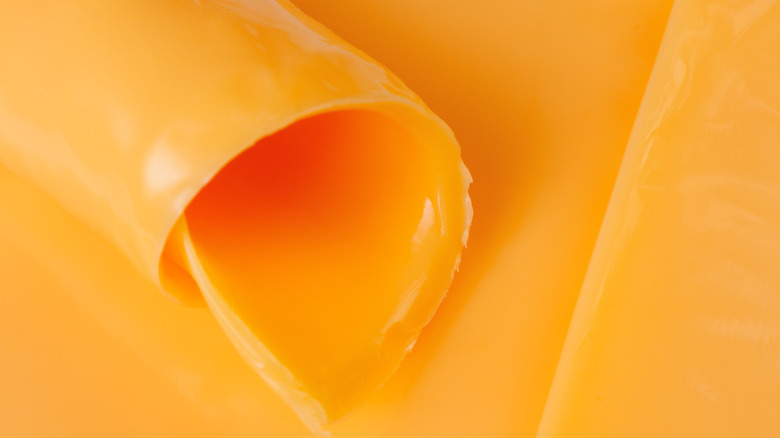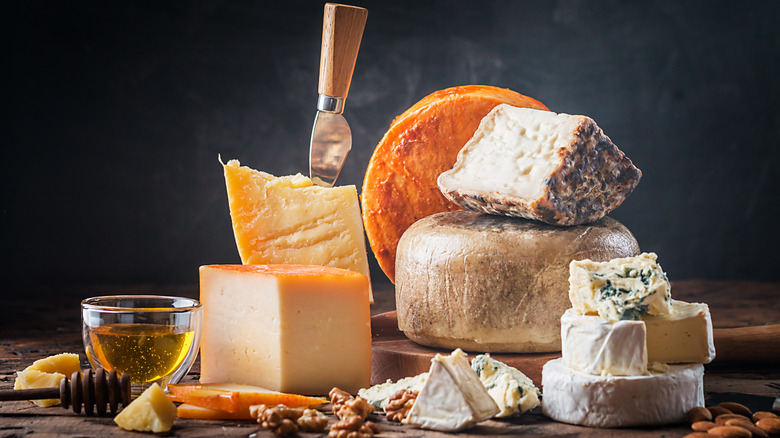Why Does The US Have A Billion Pound Surplus Of Cheese?
Gargantuan stockpiles of food are a worldwide phenomenon. According to Atlas Obscura, the E.U. is home to "butter mountains" and "wine lakes," while Canada hoards its famous maple syrup reserves. China, too, has a vast amount of frozen pork. Adding to the list of epic stores, the U.S. boasts a 1.4 billion-pound cheese surplus as of 2019, reports NPR. In total, that's about 900,000 cubic yards of cheese. The reason for this massive amount of excess dairy is simple — America produces more milk than it consumes.
Recent trends in vegan diets and milk alternatives are contributing factors to the reduction in domestic dairy consumption, says The Guardian. In addition, Americans' taste for imported cheese has risen. In contrast, their desire for American cheeses, mainly processed cheeses, has waned, writes NPR. Yet the causes for the discrepancy in milk production and consumption are complicated, and the result of an over-century-old history of America's shifting attitudes toward dairy.
America's Cheese Surplus: a Patriotic Product
The story of America's cheese surplus begins in the depression era. Andrew Novaković, an agricultural economist at Cornell University, explains, "It dates back to a time when farmers were having a tough time in the 1920s and '30s and a growing feeling that the government should help," via Atlas Obscura. To aid farmers, the U.S. government determined that certain raw and processed food products were integral to the economy and health of the nation. At the turn of the 20th century, nutritionists in the U.S. were touting dairy's health benefits for growing children and its ability to keep its military forces in fighting condition. Because of that, many Americans began to see milk as a somewhat patriotic food. Therefore, dairy items were an obvious choice for the program.
The Agricultural Act of 1949, a war effort intended to ensure food availability in the U.S., set the template for supporting farmers by storing excess dairy, according to the USDA. The government bought milk directly from farmers and turned it into processed goods with a longer shelf life — think powdered milk and American cheese singles. Due to government support, U.S. dairy farmers enjoyed a relatively reliable and steady income for decades. What could go wrong?
America's Cheese Surplus: Inflation Strikes
The U.S. cheese surplus quickly grew in size during the 1970s, due to rising inflation reports Atlas Obscura. To combat rising inflation, President Carter intervened on behalf of America's dairy farmers. He raised the price of milk and used the Agricultural Act to stock the surplus stores. With these financial incentives in place, dairy farmers found ways to produce even more milk, says CNBC, and the government received even more dairy than it anticipated. Thus, the dairy reserves started to approach the scale we are dealing with today.
By 1981, President Reagan had 560 million pounds of cheese in U.S. reserves, per Atlas Obscura. To solve the issue, he offloaded much of it into the Temporary Emergency Food Assistance Program that provided food for school lunches and welfare programs. Reagan said of this decision, "At a time when American families are under increasing financial pressure, their Government cannot sit by and watch millions of pounds of food turn into waste."
However, his decision was money-saving in addition to charitable. Storing the cheese was expensive, and he needed to put it somewhere. Of the cost to store the colossal amounts of extra milk products, a USDA official told the Washington Post, "We've looked and looked at ways to deal with this, but the distribution problems are incredible." He suggested, "Probably the cheapest and most practical thing would be to dump it in the ocean."
America's Cheese Surplus: Government Cheese
Yet Reagan's efforts did little to slow down the dairy surplus. It grew to 1.2 billion pounds, notes Atlas Obscura. By 1984, the cheese stores were so high the U.S. had five pounds of cheese per person in storage (via CNBC). In response, the government continued to produce what would soon become known as "government cheese." Government cheese looks and tastes about as interesting as its name. The blocks of bright yellow, relatively unexciting cheese became staples of American food assistance programs.
Novaković, speaking to CNBC, noted that government cheese had less than charitable purposes. "People talk about food assistance programs as if they were created to help poor people out." He explained, "that's true, but almost all of the major food assistance programs were ideas that came from agriculture because we had too much of something." The term "government cheese" gained fame in pop culture as a symbol of poverty, with references in songs by many artists, including Jay-Z and The Roots. Government cheese made appearances in SNL bits; even comedian and TV host Steve Harvey riffs about the infamous dairy product.
The writer Bobbi Dempsey describes the role of government cheese in his childhood. He says, "It brings back bittersweet feelings. It was a staple of childhood, so there's a nostalgia about that. But at the same time it's yet another aspect of life as a poor person that you had no control over," per CNBC.
America's Cheese Surplus: Changing Tastes
Over the next few decades, Americans' tastes and attitudes towards dairy shifted away from American-style processed cheese. No longer was American cheese a patriotic nutrition staple. Health-conscious Americans shied away from dairy, while others, pursuing tastier options, chose international cheeses, writes NPR. According to USDA data, the average American consumed 247 pounds of milk in 1975. That waned over the next few decades,and by 2017, milk consumption fell to 149 pounds per person per year.
The government continued to seek creative solutions to the cheese surplus problem. In the 1990s and 2000s, the USDA gave financial incentives to fast food companies to put more cheese on their menus. This strategy, which included menu items from Taco Bell and Domino's, did relieve the dairy stores by 30 million pounds of cheese, says Atlas Obscura. But the problem didn't go away. Between 2009 and 2019, the production of milk grew by 13%, according to NPR. In 2016, the surplus of milk was so large that dairy farmers did what the disgruntled Reagan-era USDA official suggested: they threw away 43 million gallons of excess milk.
Unfortunately, though the surplus came about as an attempt to aid American dairy farmers, it now hurts them. Lucas Fuess, of the consulting firm HighGround Dairy, told The Guardian: "We've seen record numbers of dairy farms close because milk prices are so low that dairy farms aren't profitable any more [sic]."
